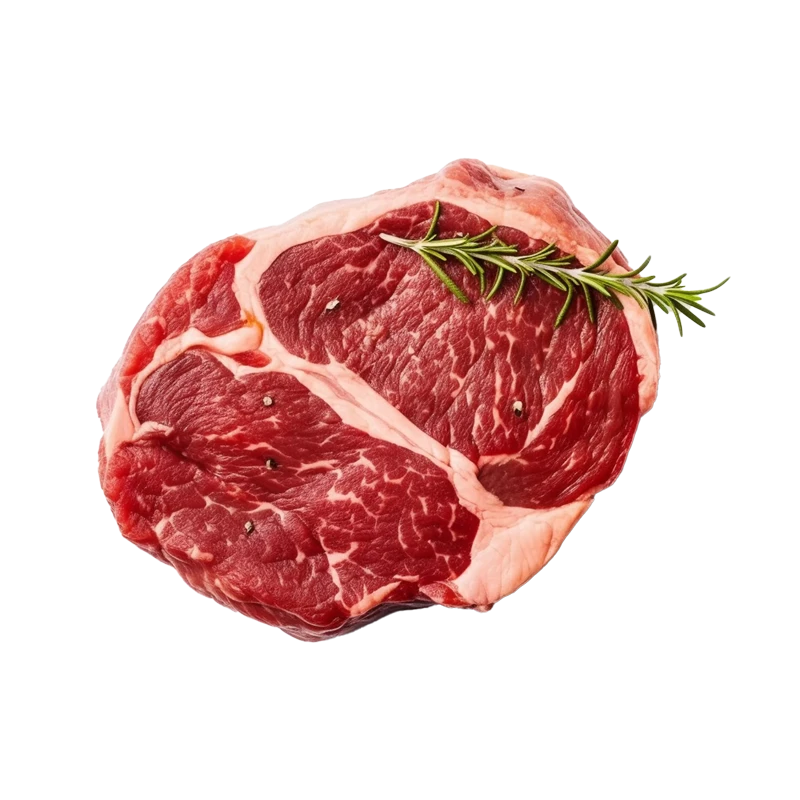Beef Steak — Nutrients, Health Benefits, and Shopping Tips

Written by Listonic Team
Last update on September 4, 2024
Nutrients
Nutrition facts
Amount per 100 g
Calories
🔥 271 kcal
| Nutrition per: 100 g | Value | % Daily Value* |
|---|---|---|
| Carbs | 0 g | - |
| Fiber | 0 g | - |
| Sugars | 0 g | - |
| Glycemic Index | 0 | - |
| Protein | 26 g | 52% |
| Sodium | 55 mg | 2.39% |
| Total Fat | 17 g | 21.79% |
*The % of Daily Value (DV) tells you how much a nutrient in a serving of food contributes to a daily diet. 2,000 calories a day is used for general nutrition advice.
26 g
💪 High Protein Content
Key takeaways
Health benefits
- High in protein, essential for muscle growth and repair.
- Rich in iron and zinc, which support immune function and overall health.
- Contains essential vitamins such as B12 and B6, which are important for energy metabolism and brain function.
- Versatile and nutritious, providing a hearty and flavorful addition to meals.
Health risks
- High sodium content especially in pre-packaged or canned versions, which can contribute to hypertension and increased cardiovascular risks.
- High fat content depending on the cuts of beef used, which can raise cholesterol levels and increase the risk of heart disease.
- Potential for overconsumption due to the hearty nature of stew, leading to excessive calorie intake if portion sizes are not controlled.
- Risk of contamination with harmful bacteria like E. coli if the beef is not cooked to a safe internal temperature.
How to choose beef steak
Thick beef steaks with clear, even marbling throughout are essential for maximum flavor. The fat should appear white or cream-colored. Steaks should be firm, cold to the touch, and moist without being wet.
Reject beef steaks that are overly thin, lack marbling, or exhibit signs of drying out, such as darkening around the edges. Any steak with a sour smell or tacky feel is likely beginning to spoil and should be avoided.

How to store beef steak
Beef steaks should be refrigerated and used within a few days for the best quality. Freezing is suitable for longer storage, where they can last up to six months. Keeping them in an airtight container or their original packaging helps preserve freshness.
Exposure to air and heat can cause beef steaks to spoil quickly. Avoid refreezing beef steaks once thawed, as this can degrade their texture. Thawing steaks in the refrigerator is the safest way to ensure they remain safe and delicious.
✅ Extra Tip
How long does it last?
Beef steak can last for 3-5 days in the refrigerator. If frozen, it can be stored for up to 6-12 months. Proper packaging, such as vacuum-sealing, helps preserve its quality over longer storage periods.
What to do with leftovers?
Leftover beef steak can be repurposed into a variety of dishes. Slice it thinly and add to sandwiches or wraps with your favorite toppings. It’s also great chopped up and mixed into a stir-fry with vegetables and rice.
Use steak slices as a topping for salads, especially when paired with a tangy vinaigrette and crunchy vegetables. You can also add the steak to a pasta dish, such as steak fettuccine, or use it as a filling for tacos or quesadillas. If you have a lot of steak, consider making a batch of steak chili or using it in a beef stew. Steak can also be served cold in a steak salad or reheated and served with eggs for a hearty breakfast. For a quick snack, top crostini with sliced steak, horseradish, and arugula.
👨⚕️️ Medical disclaimer
How beef steak supports specific health conditions
Beef steak provides a high-quality source of protein, which is essential for muscle health and repair. It is also rich in iron, promoting blood health by preventing anemia, and contains B vitamins that support brain function and energy metabolism. When consumed in moderation, lean cuts of beef steak can contribute to heart health, especially when combined with a balanced diet rich in vegetables and whole grains.
Discover products from other categories
Listonic Team
Fact-checked
Our editorial team checked this article to make sure it was accurate at the time of publishing it.
Get the top-rated shopping list app on your phone!







